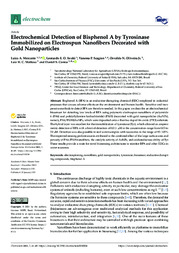Electrochemical detection of bisphenol A by tyrosinase immobilized on electrospun nanofibers decorated with gold nanoparticles.
Electrochemical detection of bisphenol A by tyrosinase immobilized on electrospun nanofibers decorated with gold nanoparticles.
Author(s): MERCANTE, L. A.; IWAKI, L. E. O.; SCAGION, V. P.; OLIVEIRA JUNIOR, O. N.; MATTOSO, L. H. C.; CORREA, D. S.
Summary: Bisphenol A (BPA) is an endocrine-disrupting chemical (EDC) employed in industrial processes that causes adverse effects on the environment and human health. Sensitive and inexpensive methods to detect BPA are therefore needed. In this paper, we describe an electrochemical biosensor for detecting low levels of BPA using polymeric electrospun nanofibers of polyamide 6 (PA6) and poly(allylamine hydrochloride) (PAH) decorated with gold nanoparticles (AuNPs), namely, PA6/PAH@AuNPs, which were deposited onto a fluorine-doped tin oxide (FTO) substrate. The hybrid layer was excellent for the immobilization of tyrosinase (Tyr), which allowed an amperometric detection of BPA with a limit of detection of 0.011 µM in the concentration range from 0.05 to 20 µM. Detection was also possible in real water samples with recoveries in the range of 92–105%. The improved sensing performance is attributed to the combined effect of the large surface area and porosity of PA6/PAH nanofibers, the catalytic activity of AuNPs, and oxidoreductase ability of Tyr. These results prov
Publication year: 2021
Types of publication: Journal article
Unit: Embrapa Instrumentation
Keywords: Biosensor, Electrospinning, Gold nanoparticles, Tyrosinase
Observation
Some of Embrapa's publications are published as ePub files. To read them, use or download one of the following free software options to your computer or mobile device. Android: Google Play Books; IOS: iBooks; Windows and Linux: Calibre.
Access other publications
Access the Agricultural Research Database (BDPA) to consult Embrapa's full library collection and records.
Visit Embrapa Bookstore to purchase books and other publications sold by Embrapa.

